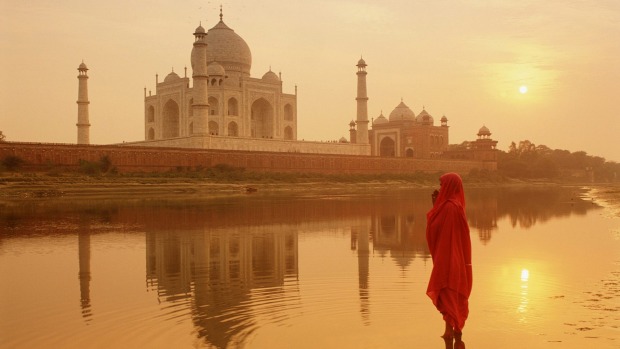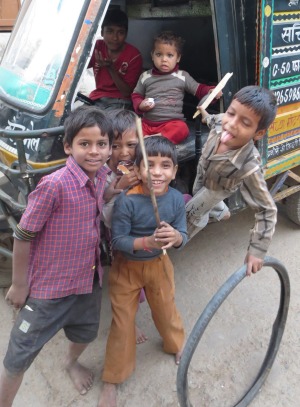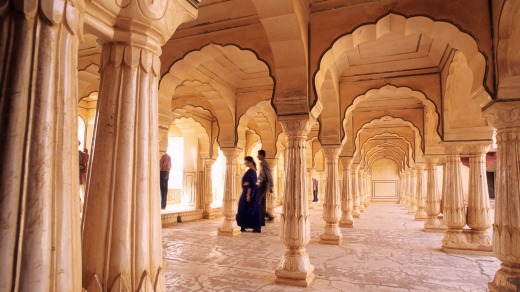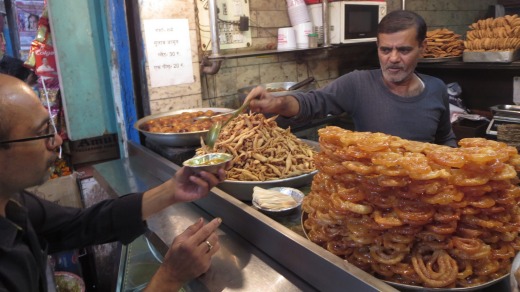
The Golden Triangle is India's most popular tourist circuit and for good reason. In a week you can tick off an enviable wish-list of temples and monuments in Delhi, get a selfie in front of the world's most famous tribute to love in Agra and shop till you flop in pink-hued Jaipur.
Many operators offer Golden Triangle tours and for the most part they're the same sanitised, arms-length itineraries that have been available for years.

But what if you want to go behind the shiny tourist facade? What if you're looking for memorable encounters rather than fleeting glimpses? Then roll up your sleeves, gird your loins and check out these immersive alternatives.
DELHI
Poverty and homelessness are inescapable facts of life in Delhi. Hundreds of children live on the streets and beg for money which ends up in the pockets of organised gangs. While it's tempting to give them something, a more effective approach is to take a walking tour organised by children's welfare charity Salaam Baalak Trust. The two-hour tours are run by adolescents who used to live on the streets, so you'll get an insight into the confronting reality of that world, plus the revenue generated helps to fund shelters, healthcare and education programs to help street kids build a better life. See salaambaalaktrust.com.

A stunning white marble building topped with golden domes, Gurudwara Bangla Sahib is Delhi's largest Sikh temple. Anyone can admire its opulent interior and listen to the stirring devotional hymns but for a more hands-on experience, ask your guide to take you into the langar, an industrial-sized kitchen where you can help prepare vegetarian meals that are served daily to hundreds of people regardless of race or religion. The practice is part of seva (meaning selfless service), a central tenet of Sikhism where followers are encouraged to spend ten per cent of their time and income helping others.
Many visitors don't make it out to the Mehrauli Archaeological Park and neighbouring Qutub Minar ruins on Delhi's outskirts and those that do often arrive with a coach-load of other tourists. A more contemplative option is to take an early-morning cycle around the park so you can admire the dozens of ruined tombs, summer palaces and colonial follies in peaceful solitude. See banyantours.com.
If you thought driving around Delhi was an adrenaline rush, try cycling. Dutch journalist Jack Leenaars started Delhi By Cycle in 2009 and now offers five guided cycling tours through different areas of the city. Trips start at the rather un-holiday hour of 6.30am but include breakfast and the bragging rights that come with tackling Delhi's chaotic streets on two wheels. See delhibycycle.com.

No visit to India's capital is complete until you've experienced the relentless sensory barrage that is Old Delhi. People will suggest taking a rickshaw ride through this tangled mess of medieval alleyways but that's a mistake. Instead, arrange a walking tour so you have time to absorb, engage and ingest. This is where you'll find some of Delhi's best street food and with the help of a knowledgeable guide to steer you in the right direction you can feast on delicious cottage cheese parathas, spiced potato samosas and sticky, syrupy deep-fried jalebi. See banyantours.com.
Where better to practice yoga than in its spiritual birthplace? For the serious practitioner, Delhi has plenty of ashrams but if you're more of an enthusiastic novice, try an early-morning class in Lodi Gardens, a tranquil, bird-filled sanctuary near India Gate. Keen to try something different? Sign up for a laughter yoga class, a playful pursuit where voluntary laughter is combined with yogic breathing. Converts say it produces the same physiological feel-good factor as the real thing. See banyantours.com.
AGRA
Since the Yamuna Expressway opened in 2012 and cut the drive time from Delhi to Agra to 2½ hours, many tourists now visit the city as a day-trip. This is a shame because not only do they miss out on seeing the Taj Mahal at sunrise and sunset, which are both magical in their own ways, but there's no time left to do anything else. Agra might not have the same range of immersive experiences as Delhi and Jaipur but there are still some gems worth checking out.
One must-do is the Mughal Heritage Walk, a community-based tourism initiative that helps people living in the villages on the banks of the Yamuna River opposite the Taj Mahal derive an income from tourism and improve their living standards.
The one-kilometre walk takes you through farmland, past examples of 16th-century Mughal architecture and into the village of Kachhpura, where you can interact with locals and learn how the revenue is helping with education, health program and sanitation.
The tour finishes in Mehtab Bagh (Moonlight Garden), a complex of manicured gardens on the banks of the Yamuna where you can watch the sunset over one of the Seven Wonders of the World. See banyantours.com.
If your visit coincides with the full moon, consider a Taj Mahal night tour, which runs on the night of the full moon and the two nights either side. Visits are restricted to 30 minutes and you don't get access to the full site but, nonetheless, the sight of the mausoleum's translucent Makrana marble glowing in the moonlight is mesmerising. See banyantours.com.
If you're fortunate enough to be staying at the Oberoi Amarvilas, located just 600 metres from the Taj Mahal, make sure you take advantage of two exclusive guest experiences. For sheer, unadulterated romance, it's hard to top a candlelit dinner on the private balcony of your suite with an uninterrupted view of the Taj Mahal. Alternatively, admire the Taj while enjoying a traditional Ayurvedic massage in the hotel's award-winning spa. See oberoihotels.com.
For a heartbreaking dose of reality, steel yourself for a visit to the Mother Teresa Orphanage. The centre takes in unwanted children, many of whom were abandoned because they were born out of wedlock or with disabilities. The orphanage's nuns are happy to give tours and while gifts and donations are not expected, they're greatly appreciated. Mother Teresa Home, Ajmer Road, Agra, Uttar Pradesh.
JAIPUR
Jaipur's star attraction is Amber Fort, a UNESCO World Heritage-listed sandstone and marble palace that sits on a hill just outside Jaipur City. The popular tourist option is to hitch a ride on one of the many elephants that trudge up and down the steep approach road all day. If you'd rather spare them this ordeal and get some exercise yourself, spend a day exploring the nearby town of Amber and hike through the surrounding Aravalli mountain range. Along the way you'll see a selection of the area's 365 temples, impressive 15th-century haveli mansions and the simple thatched roof dwellings of the local Meena hill tribe. What you won't see is a lot of other tourists. See banyantours.com.
If you'd like to interact with elephants in a more humane fashion, visit the nearby Dera Amer elephant camp. Here you can help bathe, dry and decorate an elephant before taking an elephant trek through the forest to a secluded clearing for a lantern-lit gourmet dinner. See deraamer.com.
For something totally different but equally authentic, how about learning to dance Bollywood-style? Banyan Tours can organise a private lesson with an instructor who will patiently guide you through the hip sways, finger wags and pelvic thrusts of a Bollywood dance routine. It's surprisingly hard work but enormously good fun. See banyantours.com.
Jaipur's annual kite festival on January 14 fills the skies with hundreds of colourful handmade kites. As well as beautifully choreographed displays, there's also a kite fighting competition where participants try to bring down each other's kites using glass-coated strings and other nefarious means. Don't worry if your visit doesn't coincide with this colourful spectacle, you can still learn the art of competitive kite flying with a lesson from a local expert. See banyantours.com.
To cap off your visit to Jaipur with style, why not splash out on an early-morning hot-air balloon ride? It's only from an aerial perspective that you can fully appreciate the scale of Amber fort, neighbouring Jaigarh Fort and the 18-kilometre wall that protects them (September to March, skywaltz.com).
FIVE TIPS FOR ENJOYING IMMERSIVE INDIA
DRINK BOTTLED WATER
Never drink water from the tap and use bottled water to brush your teeth.
CARRY HAND SANITISER
Regularly wash and sanitise your hands, particularly before eating.
WATCH WHAT YOU EAT
Eat only freshly-cooked food from busy restaurants. Avoid ice, fruit juices and salads.
CARRY ANTIBIOTICS
Bring some GP-prescribed antibiotics from home.
DRESS APPROPRIATELY
As a Western woman, you will get stared at, but wearing long-sleeved shirts and pants can help deflect attention.
TRIP NOTES
MORE INFORMATION
incredibleindia.org.
GETTING THERE
Air India is the only airline to fly direct from Sydney and Melbourne to Delhi. It also has connecting flights to Agra and Jaipur. Phone 1800 247 463, see airindia.in.
STAYING THERE
The Imperial hotel in Delhi is a master class in refined colonial-era elegance. Even if you don't stay, be sure to check out the decadent afternoon tea. See theimperialindia.com.
Enjoying an unrivalled position 600 metres from the Taj Mahal, the luxurious Oberoi Amarvilas is consistently rated by TripAdvisor as the number one hotel in Agra. See oberoihotels.com.
Once the home of Maharaja Man Singh II, Rambagh Palace in Jaipur exudes fairytale glamour with lavish marble interiors and 19 hectares of manicured grounds. See tajhotels.com.
SEE + DO
Banyan Tours can create a tailor-made Indian itinerary including accommodation, transfers, activities and domestic travel. See banyantours.com.